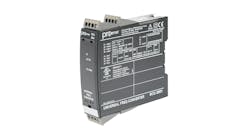Q&A: Extracting greater value via simplified, integrated IoT and advanced analytics
As the CDO at ABB Process Automation, Rajesh Ramachandran is focused on implementing new strategies to obtain greater value from vast data silos in manufacturing companies. Based on his extensive experience with big data analytics at eBay, Oracle and Rolta, combined with ABB’s process control expertise and deep domain knowledge in dozens of industry sectors, Rajesh is driving the creation of new digital platforms that simplify the task of extracting targeted data to successfully predict outcomes and optimize manufacturing processes. Processing recently connected with him about this innovative work.
Q: How can plant managers in process industries benefit from better use of data?
A: Today, the average industrial plant uses approximately 20% of the data it generates. Typically, the remaining 80% of data generated — much of it coming from the plant’s process control system as high frequency operational control (OT) data — is put in a historian and seldom used.
In addition, there are large volumes of other valuable functional data residing in a company’s general business or IT systems, and still more in the engineering systems (ET), covering specific design information for pieces of equipment. However, besides not being used to any great extent, all of this data is also normally scattered about in separate silos and networks that support little or no cross-referencing.
That’s where the golden opportunity lies, which we can now unlock with new software platforms that simplify better convergence and analysis of OT/IT/ET data. The benefits can be impressive, such as higher production rates from existing assets, less downtime via predictive maintenance practices, safer operation, reduced energy and other raw material inputs, lower environmental impact and more. You can choose to focus on any or all of these.
Q: What do you mean by better convergence of OT/IT/ET data, and what does it look like in practice?
A: In simple terms, it consists of several separate steps that have now been streamlined and integrated so that they proceed seamlessly. First, we bring all the OT, IT and ET data together in a data lake. Next, we contextualize and store related data in an industry-specific data model, like paper-making or plastic extruding, for example. Then, we apply advanced analytics and industrial AI algorithms to identify correlations that were not previously visible.
As an example, consider a motor, which is an essential and omnipresent asset used in process manufacturing plants. Regarding data, we have:
OT data — Motor speed, vibration level or bearing temperature are typical parameters monitored in real time by OT systems to tell us how the motor is currently behaving. This normally comes from automation system components such as PLCs or a DCS.
ET data — Info about things like if the motor is within its design speed limits, how much vibration it can take, the safe operating temperature for its bearings or what the useful bearing life should be is all residing within the ET (or engineering design) systems.
IT data — Next, if we want to see things like the motor’s maintenance history, when it was last serviced, how much has been spent on repairs or if the right bearings are in stock, we must find it in various IT systems, usually somewhere in the ERP solution.
Bringing it all together — Now, to get a holistic 360° overview of the motor, we integrate information from all these systems and store the relevant pieces in a contextualized data model. Finally, this allows us to visualize and activate optimum equipment operation for the best overall process results.
A motor is just one example. In a large manufacturing plant, there can be hundreds of such assets performing different functions, running under different operating conditions with varied design parameters and all having data stored in various systems. Widespread OT/IT/ET integration and contextualization is therefore critical to get a complete view of the plant — and carry out valuable analytical tasks to improve operations, asset integrity and performance management, safety, sustainability, supply chain functioning and more. This is what ABB’s new Genix platform, for example, enables. By seeing past patterns, it accurately predicts future behavior, for better process performance.
Q: Do you use AI, or perhaps machine learning, to look for these patterns and make process predictions?
A: The terms AI (artificial intelligence) and ML (machine learning) are often used interchangeably, and this can make the subject confusing at times. AI is the overarching science of making machines and physical systems smarter by embedding “artificial intelligence” in them. And ML is a subset of AI involving systems gaining knowledge over time through “self-learning” to get smarter and more predictable, without human intervention.
Yes, we have been using “industrial AI” (which includes ML) to bring a higher degree of prediction accuracy and optimization to operations, processes and assets. Combining AI with the deep industrial domain expertise that we possess — based on ABB automation systems controlling many of the world’s factories in a wide range of industries — empowers operators to run their industrial processes safer, more effectively and more sustainably.
Q: How do you make sure all this data is secure from a cybersecurity perspective?
A: That is a key question, especially since industrial manufacturing plants are a growing target of cybersecurity attacks. And, OT process data has, until recently, been subject to less strict security measures than traditional IT operations in a business.
The answer is that we have advanced cybersecurity defenses built into our software platforms and hardware devices that provide numerous levels of protection. So as the threat has been growing, so has our ability to ensure data security in the process industries — both on premises and in the cloud — to keep things safe.
Q: What do you see as the main barriers hindering implementation of advanced analytics in the process industries?
A: Honestly, the most common reason we hear for hesitation is the perceived complexity. People mistakenly think it is much more difficult to achieve than it really is. Another explanation we get is the incorrect belief that to use big data, you have to make massive capital expenditures, because it is an “all or nothing” undertaking. But it is not — you can start with small steps. Other reasons might be lack of cooperation between OT, IT and ET people and just the generally slow adoption of new digital tools in many industrial sectors.
The fact is that it is easy to join this digital mining journey, no matter where you are — and almost all companies and process professionals are at different points — by using data and signals that are already available in your process control, business and engineering systems. My best advice is simply this: Don’t be afraid, just get started. You can prioritize and choose to focus on a few quick wins, thereby creating a self-funding program to expand across the enterprise.
ABB Process Automation


